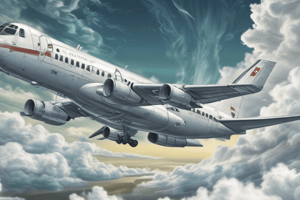Podcast
Questions and Answers
What occurs when a cold front catches up to and overtakes a warm front?
What occurs when a cold front catches up to and overtakes a warm front?
- A warm front dissipates
- An occluded front forms (correct)
- A low-pressure system develops
- A stationary front forms
What can affect the weather patterns created by an occluded front?
What can affect the weather patterns created by an occluded front?
- Air traffic control decisions
- Onboard navigation systems
- Alternative flight plans
- Topography, such as mountain ranges or bodies of water (correct)
Why is it essential for pilots to continuously monitor weather updates and forecasts when flying in frontal weather conditions?
Why is it essential for pilots to continuously monitor weather updates and forecasts when flying in frontal weather conditions?
- To adjust altitude or route
- To stay ahead of rapidly changing weather conditions (correct)
- To communicate effectively with air traffic control
- To avoid flying over mountain ranges
What can cause more severe weather conditions on the windward side of a mountain range?
What can cause more severe weather conditions on the windward side of a mountain range?
Why is it crucial for pilots to understand the characteristics of air masses and fronts?
Why is it crucial for pilots to understand the characteristics of air masses and fronts?
What is a key aspect of advanced consideration for flying in frontal weather conditions?
What is a key aspect of advanced consideration for flying in frontal weather conditions?
What can pilots do to respond to the weather changes caused by occluded fronts?
What can pilots do to respond to the weather changes caused by occluded fronts?
What type of weather patterns can occluded fronts create?
What type of weather patterns can occluded fronts create?
What is a potential outcome of air rising and cooling over a mountain range?
What is a potential outcome of air rising and cooling over a mountain range?
Why is it essential for pilots to be prepared for rapidly changing conditions when dealing with occluded fronts?
Why is it essential for pilots to be prepared for rapidly changing conditions when dealing with occluded fronts?
Occluded fronts can only form over bodies of water.
Occluded fronts can only form over bodies of water.
Pilots do not need to adjust altitude or route to avoid bad weather caused by occluded fronts.
Pilots do not need to adjust altitude or route to avoid bad weather caused by occluded fronts.
Occluded fronts can only cause one type of precipitation.
Occluded fronts can only cause one type of precipitation.
Air traffic control is not necessary for pilots to communicate with when flying in frontal weather conditions.
Air traffic control is not necessary for pilots to communicate with when flying in frontal weather conditions.
Pilots can rely solely on their onboard navigation systems to navigate through occluded fronts.
Pilots can rely solely on their onboard navigation systems to navigate through occluded fronts.
Occluded fronts are formed when a warm front catches up to and overtakes a cold front.
Occluded fronts are formed when a warm front catches up to and overtakes a cold front.
Pilots do not need to consider the topography of the terrain when flying in frontal weather conditions.
Pilots do not need to consider the topography of the terrain when flying in frontal weather conditions.
Only mountain ranges can force air upwards, leading to cooling and condensation.
Only mountain ranges can force air upwards, leading to cooling and condensation.
Occluded fronts can only cause cloud types, not precipitation.
Occluded fronts can only cause cloud types, not precipitation.
Pilots do not need to have alternative plans when flying in frontal weather conditions.
Pilots do not need to have alternative plans when flying in frontal weather conditions.
What is the primary reason why pilots need to be prepared for rapidly changing conditions when dealing with occluded fronts?
What is the primary reason why pilots need to be prepared for rapidly changing conditions when dealing with occluded fronts?
How can a mountain range affect the weather patterns created by an occluded front?
How can a mountain range affect the weather patterns created by an occluded front?
What is a key aspect of flying in frontal weather conditions that involves using onboard systems?
What is a key aspect of flying in frontal weather conditions that involves using onboard systems?
Why is it crucial for pilots to have alternative plans when flying in frontal weather conditions?
Why is it crucial for pilots to have alternative plans when flying in frontal weather conditions?
What is the primary role of air traffic control in flying in frontal weather conditions?
What is the primary role of air traffic control in flying in frontal weather conditions?
What is the outcome of air rising and cooling over a mountain range?
What is the outcome of air rising and cooling over a mountain range?
Why is understanding the characteristics of air masses and fronts essential for safe flight operations?
Why is understanding the characteristics of air masses and fronts essential for safe flight operations?
What is the primary goal of continuously monitoring weather updates and forecasts when flying in frontal weather conditions?
What is the primary goal of continuously monitoring weather updates and forecasts when flying in frontal weather conditions?
What is the relationship between occluded fronts and topography?
What is the relationship between occluded fronts and topography?
What is the primary consequence of failing to consider the topography of the terrain when flying in frontal weather conditions?
What is the primary consequence of failing to consider the topography of the terrain when flying in frontal weather conditions?
Flashcards are hidden until you start studying
Study Notes
Frontal Systems and Weather Prediction
- Frontal systems are the battlegrounds where different air masses collide, and they're central to many weather changes in aviation.
- There are four main types of fronts: cold, warm, stationary, and occluded.
- Each front associates with particular weather patterns crucial for flight planning.
Cold Fronts
- Cold fronts occur when cold air displaces warm air, often bringing thunderstorms or heavy rain, necessitating caution for potentially turbulent conditions.
- They can lead to thunderstorms, heavy rain, or snow, accompanied by a rapid drop in temperature and a shift in wind direction.
- The approach of a cold front can be identified by a line of cumulonimbus clouds, signaling potential turbulence and severe weather.
Warm Fronts
- Warm fronts occur when warm air advances over cold air, typically leading to prolonged precipitation and stratiform clouds.
- They bring light to moderate precipitation, followed by warmer and more humid conditions.
- The weather ahead of a warm front may include stratus clouds and drizzle, and fog can be a concern, reducing visibility for pilots.
Stationary Fronts
- Stationary fronts occur when a cold front or warm front stops moving, leading to prolonged periods of cloudiness and precipitation.
- They can be challenging for pilots to navigate due to the extended duration of poor flying conditions.
Occluded Fronts
- Occluded fronts form when a cold front catches up to and overtakes a warm front, causing complex weather patterns, including various types of precipitation and cloud types.
- Pilots must be prepared for rapidly changing conditions when dealing with occluded fronts.
Managing Flights through Frontal Weather
- Pre-flight preparation is crucial, obtain the most recent weather briefings, and understand the locations and movements of any fronts that may affect your path.
- In-flight strategies include being ready to deviate from your original flight plan in response to unexpected weather changes, adjusting altitude or rerouting altogether, and prioritizing safety.
- Communication with Air Traffic Control (ATC) becomes critical in these situations, as they provide real-time information and grant clearances for route changes.
- Real-time weather monitoring is essential, using advanced meteorological instruments to make informed decisions.
- It's essential to follow established safety protocols during severe frontal conditions.
Air Masses
- An air mass is a large body of air with relatively homogeneous temperature and humidity characteristics.
- The type of air mass is determined by the surface over which it forms, such as maritime or continental, and whether it originates in polar or tropical regions.
- For example, a maritime tropical (mT) air mass is warm and moist, having formed over warm ocean waters, while a continental polar (cP) air mass is cold and dry, having originated over cold land masses.
Fronts and Flight Operations
- Pilots must be able to identify the type of air mass they are flying into to anticipate potential weather changes and adjust their flight plan accordingly.
- Understanding how these fronts interact with the topography, such as mountain ranges or bodies of water, is also crucial for safe flight operations.
Frontal Systems and Weather Prediction
- Frontal systems are the battlegrounds where different air masses collide, leading to many weather changes that pilots must anticipate and manage in aviation.
- There are four main types of fronts: cold, warm, stationary, and occluded, each with its own typical weather patterns and potential hazards.
Characteristics of Fronts
- Cold Fronts:
- Form when a colder air mass advances and replaces a warmer air mass
- Often lead to thunderstorms, heavy rain, or snow, accompanied by a rapid drop in temperature and a shift in wind direction
- Can be identified by a line of cumulonimbus clouds, signaling potential turbulence and severe weather
- Warm Fronts:
- Occur when a warm air mass slides over a cold air mass
- Typically bring light to moderate precipitation, followed by warmer and more humid conditions
- Weather ahead of a warm front may include stratus clouds and drizzle, and fog can be a concern, reducing visibility for pilots
- Stationary Fronts:
- Form when a cold front or warm front stops moving
- Lead to prolonged periods of cloudiness and precipitation, and can be challenging for pilots to navigate due to the extended duration of poor flying conditions
- Occluded Fronts:
- Form when a cold front catches up to and overtakes a warm front
- Can cause complex weather patterns, including various types of precipitation and cloud types
- Pilots must be prepared for rapidly changing conditions when dealing with occluded fronts
Managing Flights through Frontal Weather
- Preparation is key: obtain the most recent weather briefings and understand the locations and movements of any fronts that may affect your path
- In-flight strategies:
- Be ready to deviate from your original flight plan in response to unexpected weather changes
- Adjust altitude or reroute altogether, always prioritizing safety
- Communication with Air Traffic Control (ATC) is critical in these situations
- Real-time weather monitoring is essential:
- Use advanced meteorological instruments on board to make informed decisions
- Circumnavigate fast-moving squall lines or avoid areas of intense wind shear
- Follow established safety protocols in severe frontal conditions:
- Err on the side of caution if severe turbulence or icing conditions are predicted or encountered
- Prioritize safety over continuing flight operations
Air Masses and Frontal Weather
- An air mass is a large body of air with relatively homogeneous temperature and humidity characteristics
- Type of air mass is determined by the surface over which it forms (maritime or continental) and its origin (polar or tropical regions)
- Characteristics of air masses have significant implications for aviation:
- When a warm air mass meets a cold air mass, the warm air is forced upward, leading to cloud formation and precipitation
- Pilots must be able to identify the type of air mass they are flying into to anticipate potential weather changes and adjust their flight plan accordingly
Frontal Systems and Weather Prediction
- Frontal systems are the battlegrounds where different air masses collide, and they're central to many weather changes we anticipate and manage in aviation.
- There are four main types of fronts: cold, warm, stationary, and occluded.
- Each front associates with particular weather patterns crucial for flight planning.
- A cold front, where cold air displaces warm air, often brings thunderstorms or heavy rain, necessitating caution for potentially turbulent conditions.
- A warm front, characterized by warm air advancing over cold air, typically leads to prolonged precipitation and stratiform clouds.
Understanding Frontal Weather Patterns
- Stationary fronts, where both air masses neither advance nor retreat, could mean persistent weather conditions for an extended duration.
- Occluded fronts occur when a cold front overtakes a warm front, leading to complex weather patterns that call for a pilot's keen interpretation skills.
- Understanding these weather patterns is critical, but knowing how they influence weather predictions is another vital layer in aviation meteorology.
Weather Prediction and Forecasting
- Pilots rely on various tools and data sources such as weather charts, satellite imagery, and forecasting models to make predictions.
- Reading between the lines of a METAR or TAF requires understanding the nuances of terminology and symbols.
- Timing of weather events is paramount and paying particular attention to updates is essential.
- Forecasts inform us not just about what to expect, but about the severity and duration of weather events we may encounter.
Managing Flights through Frontal Weather
- Pre-flight preparation is key, obtain the most recent weather briefings and understand the locations and movements of any fronts that may affect your path.
- In-flight strategies include being ready to deviate from your original flight plan in response to unexpected weather changes.
- Communication with Air Traffic Control (ATC) becomes more critical in these situations.
- Real-time weather monitoring is essential, using advanced meteorological instruments to make informed decisions.
Safety Considerations
- When it comes to severe frontal conditions, always follow established safety protocols.
- If severe turbulence or icing conditions are predicted or encountered, err on the side of caution.
- Stay flexible with your flight path, communicate with ATC, monitor weather real-time, and always adhere to safety protocols.
Case Examples
- A skilled pilot encountered an unexpected occluded front, and by assessing the situation and making timely decisions, they redirected the flight path and communicated effectively with ATC, ensuring a safe passage through what could have been a perilous situation.
Studying That Suits You
Use AI to generate personalized quizzes and flashcards to suit your learning preferences.




